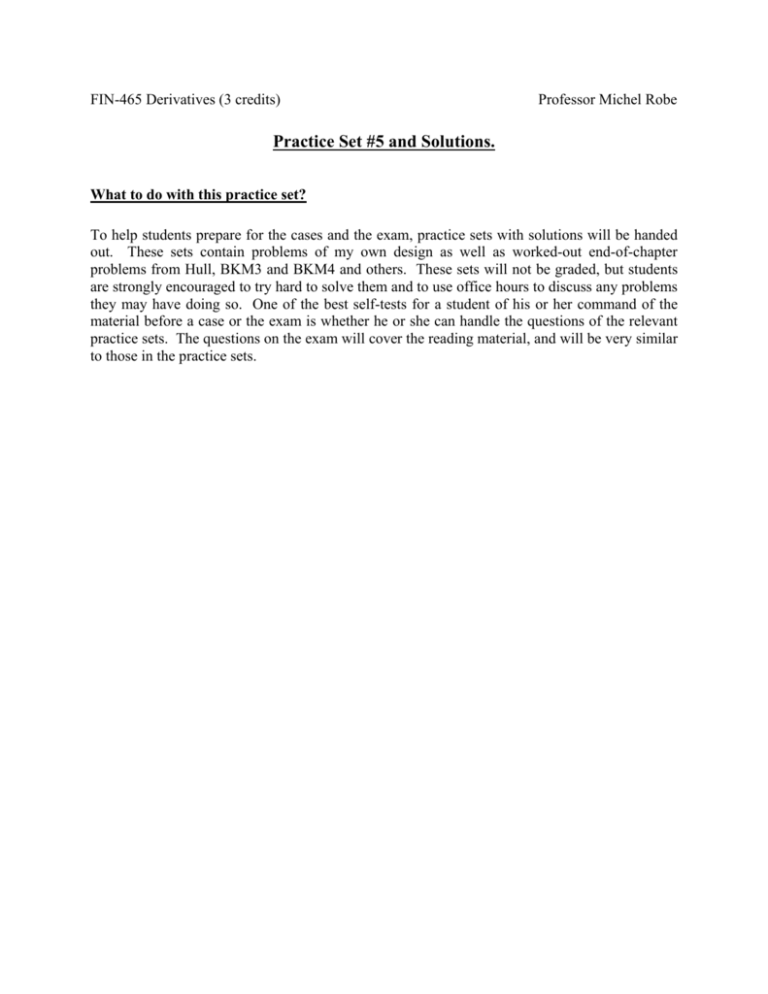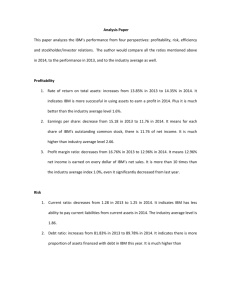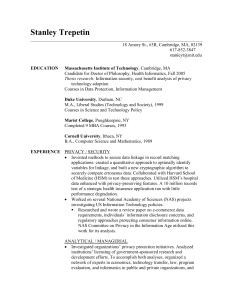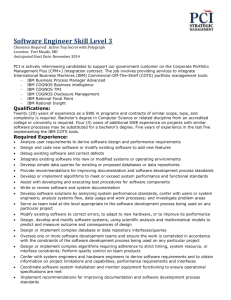Derivatives Practice Set #5 with Solutions
advertisement

FIN-465 Derivatives (3 credits) Professor Michel Robe Practice Set #5 and Solutions. What to do with this practice set? To help students prepare for the cases and the exam, practice sets with solutions will be handed out. These sets contain problems of my own design as well as worked-out end-of-chapter problems from Hull, BKM3 and BKM4 and others. These sets will not be graded, but students are strongly encouraged to try hard to solve them and to use office hours to discuss any problems they may have doing so. One of the best self-tests for a student of his or her command of the material before a case or the exam is whether he or she can handle the questions of the relevant practice sets. The questions on the exam will cover the reading material, and will be very similar to those in the practice sets. Question 1: Suppose an American call option is written on Nortel stock. The exercise price is $105 (☺) and the present value of the exercise price is $100. (a) What is the hard floor price of the option if Nortel stock sells for $160? (b) Sketch a graph of the hard floor option prices against (i.e., in terms of) the Nortel stock’s price. (c) At a stock price of $125, you notice the option selling for $18. Would this option price be an equilibrium price? Explain. (d) Although the Black-Scholes call option formula was developed for European call options, could it be legitimately used to value these American calls? Question 2: A stock is selling today for $150. If you are holding the stock today, you will receive a $15 dividend. Holding the stock tomorrow will no longer entitle you to the dividend. You are holding an American call option on the stock having an exercise price of $130. Suppose the anticipated option price is $12 when the stock price is $135. Would you hold on to your option or exercise it? Why? Question 3: The common stock of the P.U.T.T Corporation has been trading in a narrow price range for the past month, and you are convinced it is going to break far out of that range in the next three months. You do not know whether it will go up or down, however. The current price of the stock is $100 per share, and the price of a three-month call option at an exercise price of $100 is $10. (a) If the risk-free interest rate is 10% per year, what must be the price of a 3-month put option on P.U.T.T stock at an exercise price of $100? The stock pays no dividend. (b) What would be a simple options strategy to exploit your conviction about the stock price’s future movements? How far would it have to move in either direction for you to make a profit on your initial investment? Question 4: Consider the following options portfolio: you write a January maturity call option on IBM with exercise price 95. You write a January IBM put option with exercise price 85. (a) Graph the payoff of this portfolio at option expiration as a function of IBM’s stock price at that time. (b) What will be the profit/loss on this position if IBM is selling at 87 on the option maturity date? What if IBM is selling at 100? Use the Wall Street Journal listing from BKM 4, Figure 20.2, p.612 to answer this question. (Hint: Call price = $95/8; Put price = 01/16) (c) At what two stock prices will you just break even on your investment? (d) What kind of “bet” is this investor making? That is, what must this investor believe about IBM’s stock price in order to justify this position? FIN-465 Derivatives (3 credits) Professor Michel Robe Practice Set #5: Solutions. Question 1: (a) Hard floor price = VS – X = $160 - $105 = $55. (b) See p.17 of Lecture Notes 8&9, with X=105$. (b) An option price of $18 is below the hard floor price of $20. In this case, everyone would want the call option. You could then acquire a share of Nortel stock for less than the current market price. Simply buy the option (for $18), exercise it (paying $105), and you would then own a share of Nortel for a total price of $123. (c) The Black-Scholes call option procedure would be legitimate for American options if the stock paid no dividends over the remaining life of the option. This is because the right to exercise prior to maturity has no value. Question 2: It would make sense to exercise the option now. Exercising the option now, for an exercise price of $130, would give you the $15 dividend, plus a share of stock worth $135, while not exercising would mean you would hold an option worth $12 (tomorrow). Question 3: (a) From the put-call parity, we know that P = C – S + [X/(1 + r)T]. Thus, P = $10 - $100 + [$100/(1.10)1/4] = $7.645 (b) Purchase both a put and a call on the stock. This strategy is called “buying a straddle.” The total cost of the straddle would be $10 + $7.645 = $17.645, and this is the amount by which the stock would have to move in either direction for the profit on the call or put to cover the investment cost (not including time value of money considerations). If the time value of money were taken into account, the stock price would need to swing in either direction by $17.645 x (1.10)1/4 = $18.07. Question 4: (a) S < 85 85 < S < 95 S > 95 -----------------------------------------------------------------------------------Written Call 0 0 - (S - 95) Written Put - (85 - S) 0 0 ------------------------------------------------------------------------------------Total S – 85 0 95 - S (b) Proceeds from writing options (i.e., price obtained by the seller): Call = 95/8 Put = 01/16 Total = $911/16 Hence, we have: If IBM sells at $87, both options expire out of the money, and profit equals $911/16. If IBM sells at $100, the call written results in a cash outflow of $5 at maturity, and an overall profit of $911/16 - $5 = $411/16. (c) You break even when either the put or the call written results in a cash outflow of $911/16. For the put, this would require that $ 911/16 = 85 – S, or S = $ 755/16. For the call, this would require that $ 911/16 = S – 95, or S = $10411/16. (d) The investor is betting that IBM stock price will have low volatility. This position is similar to selling a strangle.








